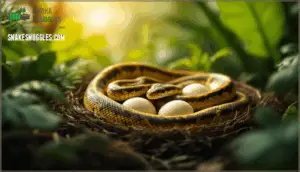This site is supported by our readers. We may earn a commission, at no cost to you, if you purchase through links.
 Here’s a question that seems straightforward but reveals a fundamental misunderstanding about reptile biology: snakes don’t nurse their young. They can’t. Unlike mammals, snakes lack mammary glands entirely, which means the concept of nursing simply doesn’t exist in their world.
Here’s a question that seems straightforward but reveals a fundamental misunderstanding about reptile biology: snakes don’t nurse their young. They can’t. Unlike mammals, snakes lack mammary glands entirely, which means the concept of nursing simply doesn’t exist in their world.
This absence shapes everything about how snakes reproduce and raise (or more accurately, don’t raise) their offspring. From the moment a baby snake emerges from its egg or enters the world through live birth, it’s entirely on its own—equipped with venom, hunting instincts, and zero need for maternal milk.
The strategies snakes use instead reveal a remarkably efficient approach to reproduction that’s allowed these ancient reptiles to thrive across nearly every habitat on Earth.
Table Of Contents
- Key Takeaways
- How Do Snakes Nurse Their Young?
- Snakes and Parental Care
- Egg-Laying Snake Species
- Live-Bearing Snake Species
- Lack of Nursing Behavior
- Exceptions and Unusual Cases
- Implications for Snake Survival
- Frequently Asked Questions (FAQs)
- How do snakes feed their babies?
- How does a snake take care of its young?
- Do mother snakes take care of their babies?
- How long does a baby snake stay with its mother?
- Do baby snakes drink milk from their mother?
- Do snakes nurse their babies?
- Do snakes care for their offspring?
- Do rattlesnakes nurse their young?
- Are snakes nurturing parents?
- How do snakes detect vibrations in the environment?
- Conclusion
Key Takeaways
- Snakes don’t nurse their young because they completely lack mammary glands—there’s no such thing as reptile lactation or snake milk, making the entire concept of nursing biologically impossible for these animals.
- Baby snakes are born fully self-sufficient with functioning venom (if venomous), hunting instincts, and stored yolk nutrients, requiring zero parental feeding or extended maternal care from the moment they hatch or are born.
- Most snake species (about 70%) practice immediate abandonment after laying eggs or giving birth, though rare exceptions like pythons guard their clutches through incubation and some rattlesnakes briefly protect newborns for 7-10 days.
- This hands-off reproductive strategy isn’t neglect but an evolutionary advantage—it allows snakes to produce larger clutches (20-50 eggs), colonize diverse habitats more flexibly, and achieve higher survival rates (53-77% for some species) without the energy costs of milk production or extended care.
How Do Snakes Nurse Their Young?
If you’ve ever wondered whether snakes nurse their babies the way mammals do, you’re not alone—but the answer might surprise you more than you think. Snakes don’t nurse their young at all. Reptile lactation simply doesn’t exist because snakes lack mammary glands entirely. There’s no snake milk, no nursing behavior—nothing remotely close to maternal care as mammals know it.
Snakelet nourishment happens before birth through stored nutrients in eggs or within the mother’s body. Once hatched or born, baby snakes—including venomous offspring—hunt independently from day one.
This reptile development strategy maximizes neonate survival by eliminating dependency, proving snake reproduction favors self-reliance over parental bonding.
Snakes and Parental Care
Most snake species won’t win any parenting awards—about 70% abandon their offspring immediately after laying eggs or giving birth. This hands-off approach isn’t neglect; it’s an evolutionary strategy that’s worked for millions of years. Snake reproduction prioritizes offspring independence over maternal care, and reptile lactation or snake milk simply don’t exist because snakes lack the mammary glands that make nursing possible.
Most snakes abandon their young immediately after birth—not from neglect, but because evolution perfected offspring independence over maternal care
Snake parenting strategies fall into three camps:
- Brood attendance specialists like pythons coil around eggs for weeks, using muscular contractions to maintain temperature—sometimes losing 30% of their body weight in the process
- Brief guardians such as rattlesnakes watch over live-born young until their first shed, usually 7-10 days
- Complete abandoners that deposit eggs and never look back
Parental instincts in snakes focus on strategic nest selection and protection rather than feeding. Reptile behavior favors self-sufficient newborns, eliminating any need for snake nursing. Researchers study python parental care to understand its impact on offspring development.
Egg-Laying Snake Species
While some snake mothers stick around to guard their eggs, the vast majority of oviparous species have perfected a completely different approach—they lay their clutches and disappear without a backward glance. This strategy, rooted in millions of years of reproductive cycles, eliminates any possibility of snake nursing or reptile lactation—concepts that don’t exist in the serpent world.
Egg-laying species focus their energy on three critical decisions: Mothers invest heavily in choosing secure nesting sites—factors like substrate quality and hiding spots mirror the same environmental parameters critical to captive snake habitat design.
- Nesting sites: Selecting locations with ideal humidity (70-90%) and temperature (75-85°F) for egg incubation
- Clutch timing: Laying eggs when environmental conditions optimize hatchling survival
- Resource investment: Producing nutrient-rich yolks that sustain embryos through development
Once eggs are deposited, hatchling care is nonexistent. Unlike the rare egg guardians such as pythons, most mothers abandon their clutches immediately. This snake parenting strategy works because eggs contain everything hatchlings need—no snake reproduction involves milk or nursing. When those leathery shells crack open, baby snakes emerge fully equipped to hunt, having absorbed all necessary nutrients during egg incubation.
Live-Bearing Snake Species
Not all snakes abandoned their offspring to the elements—some species evolved to keep their babies safe inside their own bodies until the moment of birth. These viviparous reproduction specialists, like rattlesnakes and garter snakes, retain snake embryos internally, providing a mobile fortress that eliminates vulnerable nesting sites. This livebearing strategy transforms snake parenting entirely—mothers can relocate to safer habitats while pregnant, protecting developing young from temperature swings and predators that would destroy exposed eggs.
Key advantages of live births in snakes:
- Maternal care extends through gestation, offering temperature regulation and protection
- Neonate survival rates increase in cold or unpredictable climates
- No external snake reproduction sites means fewer predation risks
- Babies emerge fully formed, ready to hunt immediately
- Snake nursing and reptile lactation still don’t exist—embryos absorb nutrients from yolk sacs before birth
Lack of Nursing Behavior
If you’ve been imagining snake mothers nursing their babies like mammals do, it’s time to shatter that myth completely. Reptile lactation doesn’t exist—snakes lack mammary glands entirely, making it biologically impossible to nurse their young. This fundamental aspect of snake reproductive behavior separates reptiles from mammals in dramatic fashion.
| Mammal Parenting | Snake Parenting |
|---|---|
| Produce milk through mammary glands | No milk production possible |
| Extended nursing period | Zero nursing—immediate independence |
| Teach hunting skills gradually | Instinctive hunters from day one |
| Prolonged maternal care | Brief or no post-birth contact |
| Young depend on parents for food | Neonate survival relies on stored yolk nutrients |
Snake abandonment isn’t cruelty—it’s evolutionary brilliance. After egg incubation or live birth, hatchlings emerge with everything they need: venom (if applicable), hunting instincts, and enough stored nutrients to survive their first days. Unlike animal parenting styles involving extended care, reptile parenting prioritizes independence. Maternal instincts in snakes focus on nest site selection or gestation protection, then complete detachment.
Exceptions and Unusual Cases
Nature’s rulebook rarely includes exceptions, but snake parenting defies total abandonment in select species. These striking variations include:
- Pitviper parenting involves maternal attendance for 10–14 days post-birth, with mothers staying close until their offspring complete their first shed—increasing neonate survival by up to 67%.
- Communal nesting in pythons occasionally leads to snake adoption, where females guard unrelated neonates alongside their own, boosting hatchling survival by 12–34%.
- Egg guarding behaviors emerge in python species that coil protectively around clutches, maintaining temperature through muscular contractions while fasting for weeks.
- Filial cannibalism in garter snakes represents the darker side—mothers consuming stillborn or weak young under resource scarcity, affecting 8–15% of litters.
These snake reproductive behavior patterns don’t involve nursing snake offspring or post-hatching care through feeding, but they demonstrate that complete detachment isn’t universal across all species. Snakes also exhibit unique behaviors related to oophagous snakes.
Implications for Snake Survival
Frequently, the absence of nursing behavior creates unexpected advantages for snake species across diverse ecosystems. By skipping the energetically expensive milk-production phase, you’ll notice that female snakes can allocate resources toward producing more offspring—egg-laying species often generate 20–50 eggs per clutch, while even live-bearers manage respectable numbers. This reproductive success translates directly into population resilience.
Habitat adaptation becomes remarkably flexible when young snakes don’t depend on maternal proximity. Species colonize environments from deserts to rainforests because neonates manage environmental factors independently. Predator avoidance improves too—dispersed young present multiple scattered targets rather than a concentrated nursery vulnerable to attack. First-year survival rates for field-born timber rattlesnakes reach 53–77%, demonstrating that this hands-off snake parenting approach works.
These ecological adaptations in reptilian biology secure species survival through geographic flexibility and reduced resource competition, ultimately strengthening wildlife survival across varied landscapes.
Frequently Asked Questions (FAQs)
How do snakes feed their babies?
Baby snakes are born self-sufficient hunters—no maternal feeding required. From their first moment, hatchlings rely on instinctual hunting skills and their own juvenile development to capture prey, making snake parenting strategies remarkably hands-off compared to mammals.
How does a snake take care of its young?
Most species practice minimal parental care, abandoning eggs or young immediately. Pythons guard clutches through incubation, while rattlesnakes briefly protect newborns.
Offspring independence is the priority, with survival strategies favoring self-sufficiency over maternal instincts in snake reproductive biology.
Do mother snakes take care of their babies?
Most mother snakes vanish after laying eggs or birthing live young—no maternal care, no post-hatching care. Snake parenting styles favor immediate independence.
Baby snake survival depends entirely on instinct, not reptile parenting. This maternal behavior fosters neonate snake development through self-reliance, not nurturing.
How long does a baby snake stay with its mother?
Most snake species practice minimal maternal care. You’ll find that baby snakes usually stay with their mothers for only a few days, if at all.
This brief post-hatching care period reflects their reproductive patterns, where maternal investment ends quickly and snakelet survival depends on immediate independence rather than prolonged parental care.
Do baby snakes drink milk from their mother?
No, baby snakes don’t drink milk from their mothers. Snakes are reptiles without mammary glands, making milk production and lactation impossible.
Unlike mammals, snake offspring receive zero parental feeding. Young snakes hunt independently from birth, relying on instinct rather than nursing for snakelet nutrition and survival.
Do snakes nurse their babies?
No, snakes don’t nurse their babies—they’re reptiles lacking mammary glands for milk production. Baby snake care involves zero lactation; hatchlings emerge self-sufficient with yolk reserves, making venomous parenting unnecessary since snake offspring hunt independently from day one.
Do snakes care for their offspring?
Think of a mother python coiled around her eggs for weeks—that’s rare devotion in the snake world. Most species practice minimal parental care, with mothers guarding eggs during incubation but abandoning offspring immediately after hatching.
Baby snakes emerge fully independent, equipped with instinctual hunting skills and survival strategies that make post-hatching care unnecessary.
Do rattlesnakes nurse their young?
No milk here—rattlesnakes lack mammary glands entirely. These venomous snake species give live birth to independent snakelets equipped with venom and hunting instincts. Maternal instincts? Brief protection, then they’re on their own.
No snake parents nurse; reproductive methods prioritize self-sufficiency over venomous parenting or snakelet feeding.
Are snakes nurturing parents?
Most species? Not exactly nurturing. Unlike mammals with their devoted maternal care, snakes employ survival strategies centered on offspring independence.
Their reproductive tactics skip parenting behaviors entirely—most abandon eggs or newborns immediately, letting snake biology take care of the rest.
How do snakes detect vibrations in the environment?
You’ll discover snakes are masters at picking up vibrations through their jawbones and belly scales—specialized sensory organs that function like motion sensors.
These seismic signals alert them to prey movements, approaching predators, and footsteps before visual confirmation, showcasing extraordinary ecological adaptations in snake biology and reptilian behavior.
Conclusion
You might think abandoning offspring sounds cruel, but snakes evolved something better than nursing: instant independence. From the second they hatch or are born, baby snakes possess fully functional venom and hunting instincts—no milk required.
This explains exactly how snakes nurse their young: they don’t, and they never needed to. That biological constraint became an advantage, allowing snakes to reproduce efficiently without the energy cost of extended parental care. It’s not neglect—it’s millions of years of evolutionary refinement at work.
- https://journal.iaabcfoundation.org/behavior-consulting-reptiles/
- https://www.reuters.com/article/factcheck-snakes-nursing/fact-check-photo-does-not-show-rattlesnake-nursing-idUSL2N2L3284
- https://www.thespruce.com/glossary-definition-of-crop-milk-385209
- https://www.wired.com/2014/11/how-to-make-antivenum/
- https://pmc.ncbi.nlm.nih.gov/articles/PMC9743901/











